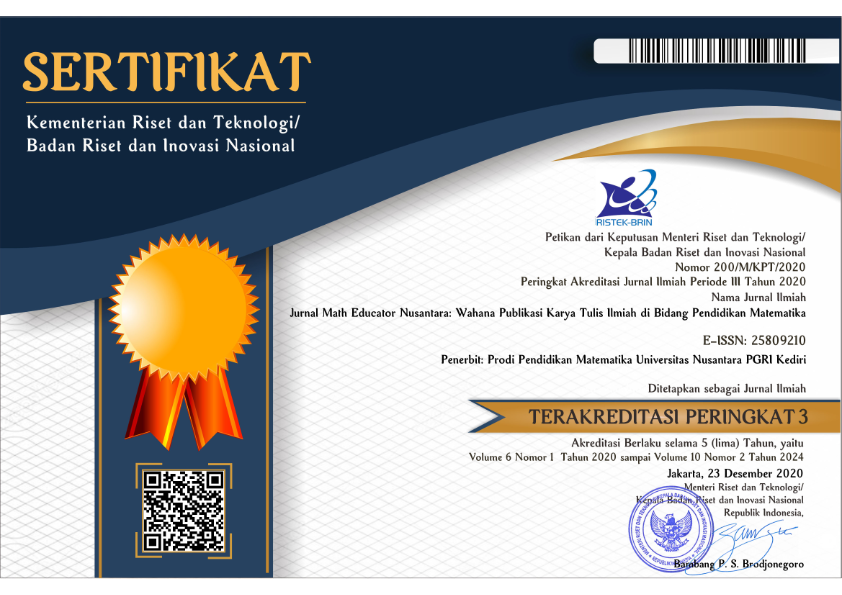Application of active, collaborative and inductive cooperative learning models in improving junior high school students' mathematical generalization ability
DOI:
https://doi.org/10.29407/jmen.v10i1.21660Keywords:
Mathematical generalization abilities, cooperative learning models, active learning, collaboration, inductiveAbstract
The mathematical generalization ability of students at one junior high school, especially in Makassar, is relatively low. One alternative to improve students' mathematical generalization abilities is to apply active, collaborative and inductive cooperative learning models. This research aims to determine the difference in the average score of mathematical generalization abilities of students taught through active, collaborative and inductive cooperative learning models, and students taught through cooperative learning models on flat-sided geometric material. This research used a quasi-experimental design with a pretest-posttest control group design in class VIII at a junior high school in Makassar, Indonesia. The sample in this study was 35 students in the control group and 31 students in the experimental group. The instrument used is a mathematical generalization ability test. Data were analyzed using the n gain test. Based on the analysis, the average n-gain score for students' mathematical generalization abilities in flat-sided geometric material after being taught by applying active, collaborative and inductive cooperative learning models was 0,51 or experienced a moderate increase and the percentage of learning completeness was 93,55%. Therefore, it can be concluded that junior high school students' mathematical generalization abilities increased after being taught using active, collaborative and inductive cooperative learning models.
References
Amiruddin. (2019). Pembelajaran Kooperatif dan Kolaboratif. Journal of Education Science, 5(1), 24–32.
Anggoro, B. S. (2016). Meningkatkan Kemampuan Generalisasi Matematis Melalui Discovery Learning dan Model Pembelajaran Peer Led Guided Inquiry. Al-Jabar: Jurnal Pendidikan Matematika, 7(1), 11–20. http://dx.doi.org/10.24042/ajpm.v7i1.9663
Arikunto, S. (2013). Prosedur Penelitian Suatu Pendekatan Praktik. PT. Rineka Cipta.
Child, S. (2016). Collaboration In The 21st Century: Implications For Assessment. Research Matters: A Cambridge Assessment Publication, 22, 17–22.
Depdiknas. (2006). Kurikulum Tingkat Satuan Pendidikan. Depdiknas.
Dewi, M. R., Mudakir, I., & Murdiyah, S. (2016). Pengaruh Model Pembelajaran Kolaboratif berbasis Lesson Study terhadap Kemampuan Berpikir Kritis Siswa. Jurnal Edukasi, 3(2), 29–33. https://doi.org/10.19184/jukasi.v3i2.3526
Dooley, K., & Sexton-Finck, L. (2017). A focus on collaboration: Fostering Australian screen production students’ teamwork skills. Journal of Teaching and Learning for Graduate Employability, 8(1), 74–105. https://doi.org/10.21153/jtlge2017vol8no1art642
Fitrianna, A. Y., Priatna, N., & Dahlan, J. A. (2021). Pengembangan Model E-Book Interaktif Berbasis Pembelajaran Induktif untuk Melatihkan Kemampuan Penalaran Aljabar Siswa SMP. Jurnal Cendekia : Jurnal Pendidikan Matematika, 5(2), 1562–1577. https://doi.org/10.31004/cendekia.v5i2.653
Hallinger, P., Tran, N. H., & Truong, T. D. (2023). Mapping the professional learning of primary teachers in Vietnam: A multi-method case study. Professional Development in Education, 49(5), 856–870. https://doi.org/10.1080/19415257.2021.1879218
Joyce, B., Weil, M., & Calhoun, E. (2011). Models of Teaching: Model-Model Pengajaran. Edisi Kedelapan (Achmad Fawaid & Ateilla Mirza, penterjemah). Pustaka Pelajar.
Kawuri, M. Y. R. T., Ishafit, I., & Fayanto, S. (2019). Efforts To Improve The Learning Activity And Learning Outcomes Of Physics Students With Using A Problem-Based Learning Model. IJIS Edu : Indonesian Journal of Integrated Science Education, 1(2), 105–114. https://doi.org/10.29300/ijisedu.v1i2.1957
Nasir, A. M. (2016). Statistik Pendidikan. Media Akademi.
Nasrulloh, I., & Ismail, A. (2018). ANALISIS KEBUTUHAN PEMBELAJARAN BERBASIS ICT. JURNAL PETIK, 3(1), 28–32. https://doi.org/10.31980/jpetik.v3i1.355
Nicol, A. A., Owens, S. M., Le Coze, S. S., MacIntyre, A., & Eastwood, C. (2018). Comparison of high-technology active learning and low-technology active learning classrooms. Active Learning in Higher Education, 19(3), 253–265. https://doi.org/10.1177/1469787417731176
Rizkiyah, V. N. S., & Rahaju, E. B. (2018). PENALARAN GENERALISASI SISWA SMP DALAM MEMECAHKAN MASALAH PADA MATERI BARISAN BILANGAN DITINJAU BERDASARKAN TIPE KEPRIBADIAN. MATHEdunesa: Jurnal Ilmiah Pendidikan Matematika, 7(2), 1–10. https://doi.org/10.26740/mathedunesa.v7n2.p406-415
Rusman. (2012). Model-model Pembelajaran Mengembangkan Profesionalisme Guru. Rajawali Pers.
Shoimin. (2014). 68 Model Pembelajaran INOVATIF dalam Kurikulum 2013. Ar-Ruzz Media.
Sugiyono. (2010). Metode Penelitian Kuantitatif Kualitatif dan R&D. Alfabeta.
Sulistiyo, S. (2020). Peran Guru Dalam Meningkatkan Motivasi Pembelajaran Matematika Sekolah Dasar Pada Siswa Kelas Tinggi. At-Ta’lim: Kajian Pendidikan Agama Islam, 2(1), 104–113. http://www.ejournal.annadwah.ac.id/index.php/Attalim/article/view/138
Sumarmo, U. (2010). Berpikir Dan Disposisi Matematik: Apa, Mengapa, Dan Bagaimana Dikembangkan Pada Peserta Didik. Makalah FPMIPA UPI.
Sumarmo, U. (2013). Kumpulan Makalah Berpikir dan Disposisi Matematik Serta Pembelajarannya. Universitas Pendidikan Indonesia.
Suryani, N. (2009). Implementasi Model Pembelajaran Kolaboratif Untuk Meningkatkan Ketrampilan Sosial Siswa. Majalah Ilmiah Pembelajaran, 6(2).
Tharayil, S., Borrego, M., Prince, M., Nguyen, K. A., Shekhar, P., Finelli, C. J., & Waters, C. (2018). Strategies to mitigate student resistance to active learning. International Journal of STEM Education, 5(1), 1–16. https://doi.org/10.1186/s40594-018-0102-y
Ulhusna, M., Putri, S. D., & Zakirman, Z. (2020). Permainan Ludo untuk Meningkatkan Keterampilan Kolaborasi Siswa dalam Pembelajaran Matematika. International Journal of Elementary Education, 4(2), 130–137. https://doi.org/10.23887/ijee.v4i2.23050
Wanti, N., Juariah, J., Farlina, E., Kariadinata, R., & Sugilar, H. (2017). Pembelajaran Induktif Pada Kemampuan Penalaran Matematis dan Self-Regulated Learning Siswa. Jurnal Analisa, 3(1), 56–69. https://doi.org/10.15575/ja.v3i1.1497
Yin, K. Y., Abdullah, A. G. K., & Alazidiyeen, N. J. (2011). Collaborative Problem Solving Methods towards Critical Thinking. International Education Studies, 4(2), 58–62. https://doi.org/10.5539/ies.v4n2p58
Downloads
Published
Issue
Section
License
Authors who publish with this journal agree to the following terms:
- Copyright on any article is retained by the author(s).
- The author grants the journal, the right of first publication with the work simultaneously licensed under a Creative Commons Attribution License that allows others to share the work with an acknowledgment of the work’s authorship and initial publication in this journal.
- Authors are able to enter into separate, additional contractual arrangements for the non-exclusive distribution of the journal’s published version of the work (e.g., post it to an institutional repository or publish it in a book), with an acknowledgment of its initial publication in this journal.
- Authors are permitted and encouraged to post their work online (e.g., in institutional repositories or on their website) prior to and during the submission process, as it can lead to productive exchanges, as well as earlier and greater citation of published work.
- The article and any associated published material is distributed under the Creative Commons Attribution-ShareAlike 4.0 International License















